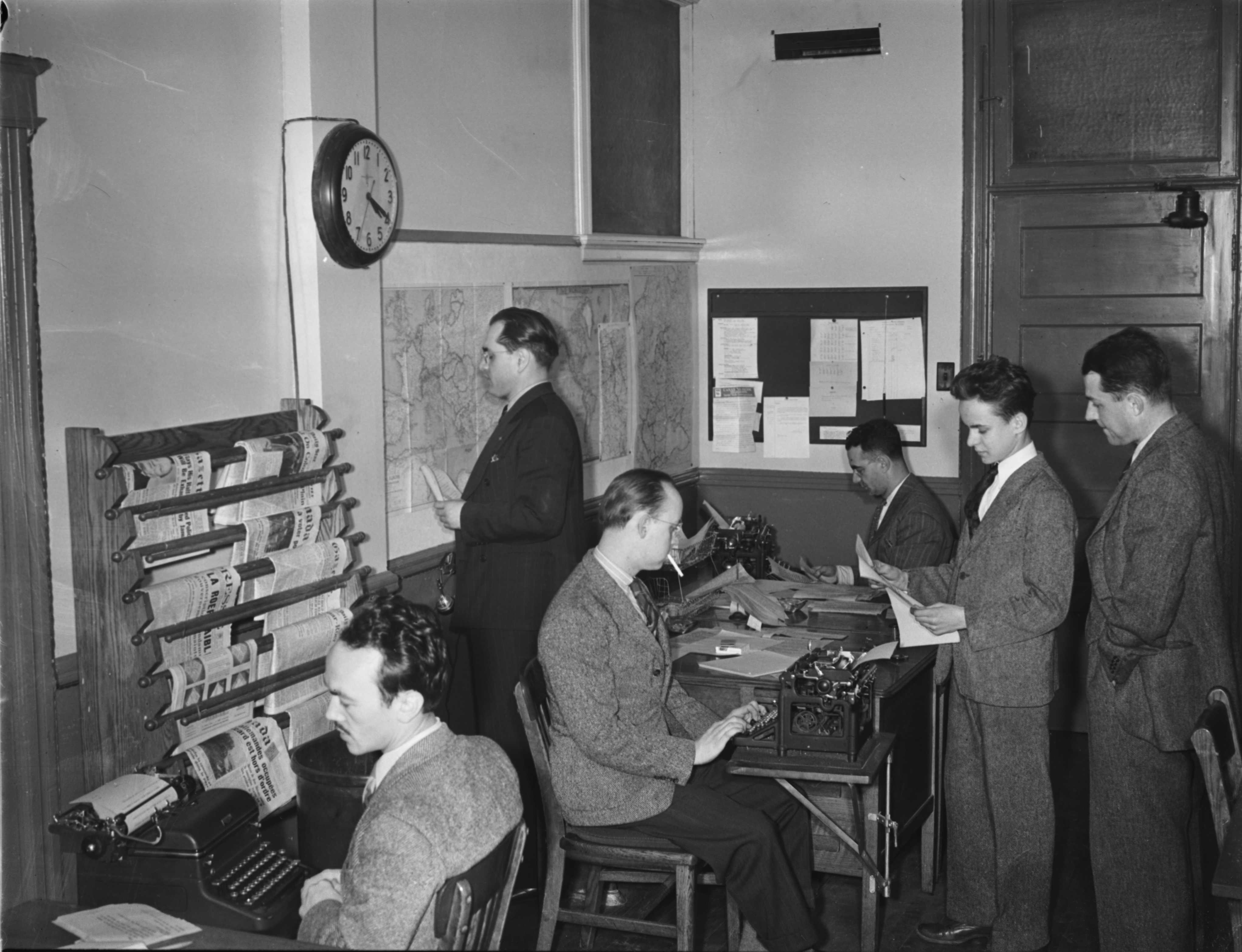|
CTV Television Network
The CTV Television Network, commonly known as CTV, is a Canadian English-language terrestrial television network. Launched in 1961 and acquired by BCE Inc. in 2000, CTV is Canada's largest privately owned television network and is now a division of the Bell Media subsidiary of BCE. It is Canada's largest privately or commercially owned network consisting of 22 owned-and-operated stations nationwide and two privately owned affiliates, and has consistently been placed as Canada's top- rated network in total viewers and in key demographics since 2002, after several years trailing the rival Global Television Network in key markets. Bell Media also operates additional CTV-branded properties, including the 24-hour national cable news network CTV News Channel and the secondary CTV Two television system. There has never been an official full name corresponding to the initials "CTV"; prior to CTV's launch in 1961, it was given the proposed branding of "Canadian Television Network" ( ... [...More Info...] [...Related Items...] OR: [Wikipedia] [Google] [Baidu] |
Terrestrial Television
Terrestrial television or over-the-air television (OTA) is a type of television broadcasting in which the signal transmission occurs via radio waves from the terrestrial (Earth-based) transmitter of a television station, TV station to a television set, TV receiver having an television antenna, antenna. The term ''terrestrial'' is more common in Europe and Latin America, while in Canada and the United States it is called ''over-the-air'' or simply ''broadcast''. This type of Television broadcasting, TV broadcast is distinguished from newer technologies, such as satellite television (direct broadcast satellite or DBS television), in which the signal is transmitted to the receiver from an overhead satellite; cable television, in which the signal is carried to the receiver through a coaxial cable, cable; and Internet Protocol television, in which the signal is received over an Internet stream or on a network utilizing the Internet Protocol. Terrestrial television stations broadcast o ... [...More Info...] [...Related Items...] OR: [Wikipedia] [Google] [Baidu] |
CTV Life Channel
CTV Life Channel is a Canadian English language specialty channel owned by Bell Media. The channel primarily broadcasts factual and reality programming on lifestyle topics such as cooking, home improvement and real estate, along with scripted drama series. The channel was originally established in 2013 by Knight Enterprises as the Category B service Gusto TV. In May 2016, Knight sold Canadian rights to the Gusto brand and associated programming to Bell Media. The company would relaunch the channel on September 1, using a Category A license formerly used by its music and entertainment channel M3 (formerly MuchMoreMusic, which was launched in 1998 by CHUM Limited). As part of a rebranding of several Bell Media-owned specialty channels, the channel rebranded as CTV Life Channel on September 12, 2019. History Under Knight Enterprises In October 2010, Chris Knight was granted approval by the Canadian Radio-television and Telecommunications Commission (CRTC) to operate "Mm ... [...More Info...] [...Related Items...] OR: [Wikipedia] [Google] [Baidu] |
John Diefenbaker
John George Diefenbaker ( ; September 18, 1895 – August 16, 1979) was the 13th prime minister of Canada, serving from 1957 to 1963. He was the only Progressive Conservative party leader between 1930 and 1979 to lead the party to an election victory, doing so three times, although only once with a majority of the seats in the House of Commons. Diefenbaker was born in southwestern Ontario in the small town of Neustadt in 1895. In 1903, his family migrated west to the portion of the North-West Territories which would soon become the province of Saskatchewan. He grew up in the province and was interested in politics from a young age. After service in World War I, Diefenbaker became a noted criminal defence lawyer. He contested elections through the 1920s and 1930s with little success until he was finally elected to the House of Commons in 1940. Diefenbaker was repeatedly a candidate for the party leadership. He gained that position in 1956, on his third attempt. In 1957, ... [...More Info...] [...Related Items...] OR: [Wikipedia] [Google] [Baidu] |
Canadian Broadcasting Corporation
The Canadian Broadcasting Corporation (french: Société Radio-Canada), branded as CBC/Radio-Canada, is a Canadian public broadcaster for both radio and television. It is a federal Crown corporation that receives funding from the government. The English- and French-language service units of the corporation are commonly known as CBC and Radio-Canada, respectively. Although some local stations in Canada predate the CBC's founding, CBC is the oldest existing broadcasting network in Canada. The CBC was established on November 2, 1936. The CBC operates four terrestrial radio networks: The English-language CBC Radio One and CBC Music, and the French-language Ici Radio-Canada Première and Ici Musique. (International radio service Radio Canada International historically transmitted via shortwave radio, but since 2012 its content is only available as podcasts on its website.) The CBC also operates two terrestrial television networks, the English-language CBC Television and the F ... [...More Info...] [...Related Items...] OR: [Wikipedia] [Google] [Baidu] |
Television System
In Canada, a television system is a group of television stations which share common ownership, branding and programming, but which for some reason does not satisfy the criteria necessary for it to be classified as a television network under Canadian law. As the term "television system" has no legal definition, and as most audiences and broadcasters usually refer to groups of stations with common branding and programming as "networks" regardless of their structure, the distinction between the two entities is often not entirely clear; indeed, the term is rarely discussed outside the Canadian broadcasting enthusiast community. In the latter regard, however, a group of Canadian stations is currently considered a "network" if it satisfies at least one of the following requirements: * it operates under a network licence (either national or, in the case of Quebec where the majority of Canada's francophones reside, provincial) issued by the Canadian Radio-television and Telecommunication ... [...More Info...] [...Related Items...] OR: [Wikipedia] [Google] [Baidu] |
CTV Two
CTV 2 is a Television in Canada, Canadian English language, English-language television system owned by the Bell Media subsidiary of BCE Inc. The system consists of four terrestrial owned-and-operated station, owned-and-operated television stations (O&Os) in Ontario, one in British Columbia and two regional cable television channels, one in Atlantic Canada and the other in Alberta (the latter formerly being the provincial educational channel in that province under the name Access Alberta). The CTV 2 system began in 1995 as NewNet, which was originated from the station CKVR-DT, CKVR-TV, owned by CHUM Limited, who disaffiliated from the CBC and modeled its format aimed at younger viewers after its Citytv station, CITY-DT, CITY-TV in Toronto. The NewNet system expanded with the acquisition of four Baton Broadcasting stations in Southern Ontario, followed by the launch of CIVI-DT, CIVI-TV in Vancouver Island. NewNet was rebranded to A-Channel in 2005 after acquiring the assets of Crai ... [...More Info...] [...Related Items...] OR: [Wikipedia] [Google] [Baidu] |
CTV News Channel (Canada)
CTV News Channel is a Canadian specialty news channel owned by Bell Media (a wholly owned subsidiary of Bell Canada). It broadcasts national and international news headlines, breaking news, and information. The channel is headquartered at 9 Channel Nine Court in the Agincourt neighbourhood of Scarborough in Toronto, Ontario. History In September 1996, CTV Television Network Ltd. (a division of CTV) was granted a broadcast licence by the Canadian Radio-television and Telecommunications Commission (CRTC) for CTV N1, a national English language specialty television service that would broadcast "news, weather and sports reports, as well as business, consumer and lifestyle information", in a 'headline news' format on a 15-minute news wheel. The channel was launched on October 17, 1997 as CTV News 1. Under the terms of this licence, the channel broadcast news and information on a 15-minute wheel, beginning a new cycle every 15 minutes using a pre-recorded, server-hosted configurati ... [...More Info...] [...Related Items...] OR: [Wikipedia] [Google] [Baidu] |
Global Television Network
The Global Television Network (more commonly called Global, or occasionally Global TV) is a Canadian English-language terrestrial television network. It is currently Canada's second most-watched private terrestrial television network after CTV, and has fifteen owned-and-operated stations throughout the country. Global is owned by Corus Entertainment — the media holdings of JR Shaw and other members of his family. Global has its origins in a regional television station of the same name, serving Southern Ontario, which launched in 1974. The Ontario station was soon purchased by the now-defunct CanWest Global Communications, and that company gradually expanded its national reach in the subsequent decades through both acquisitions and new station launches, building up a quasi-network of independent stations, known as the CanWest Global System, until the stations were unified under the Ontario station's branding in 1997. History NTV The network has its origins in NTV, a new ... [...More Info...] [...Related Items...] OR: [Wikipedia] [Google] [Baidu] |
Demographic
Demography () is the statistical study of populations, especially human beings. Demographic analysis examines and measures the dimensions and dynamics of populations; it can cover whole societies or groups defined by criteria such as education, nationality, religion, and ethnicity. Educational institutions usually treat demography as a field of sociology, though there are a number of independent demography departments. These methods have primarily been developed to study human populations, but are extended to a variety of areas where researchers want to know how populations of social actors can change across time through processes of birth, death, and migration. In the context of human biological populations, demographic analysis uses administrative records to develop an independent estimate of the population. Demographic analysis estimates are often considered a reliable standard for judging the accuracy of the census information gathered at any time. In the labor ... [...More Info...] [...Related Items...] OR: [Wikipedia] [Google] [Baidu] |
Audience Measurement
Audience measurement measures how many people are in an audience, usually in relation to radio listenership and television viewership, but also in relation to newspaper and magazine readership and, increasingly, web traffic on websites. Sometimes, the term is used as pertaining to practices which help broadcasters and advertisers determine ''who'' is listening rather than just ''how many'' people are listening. In some parts of the world, the resulting relative numbers are referred to as audience share, while in other places the broader term market share is used. This broader meaning is also called audience research. Measurements are broken down by media market, which for the most part corresponds to metropolitan areas, both large and small. Methods Diaries The diary was one of the first methods of recording information. However, this is prone to mistakes and forgetfulness, as well as subjectivity. Data is also collected down to the level of listener opinion of ind ... [...More Info...] [...Related Items...] OR: [Wikipedia] [Google] [Baidu] |
List Of Canadian Television Channels
Television in Canada has many individual stations, networks, and systems. National broadcast television networks English * CBC Television, a national public network owned by the Canadian Broadcasting Corporation (CBC). * Citytv, a privately owned television network owned by Rogers Media, with stations in Quebec, Ontario, Manitoba, Saskatchewan, Alberta and British Columbia. * CTV Television Network, a national private network (except for Newfoundland and Labrador and the territories) owned by Bell Media. * Global Television Network, a national private network (except for Newfoundland and Labrador and the territories) owned by Corus Entertainment. French * Ici Radio-Canada Télé, a national public network owned by the CBC's French-language division Société Radio-Canada. * TVA, a privately owned television network owned by Groupe TVA. Multilingual * Aboriginal Peoples Television Network, a broadcast television network with television stations in the three territories and cab ... [...More Info...] [...Related Items...] OR: [Wikipedia] [Google] [Baidu] |



